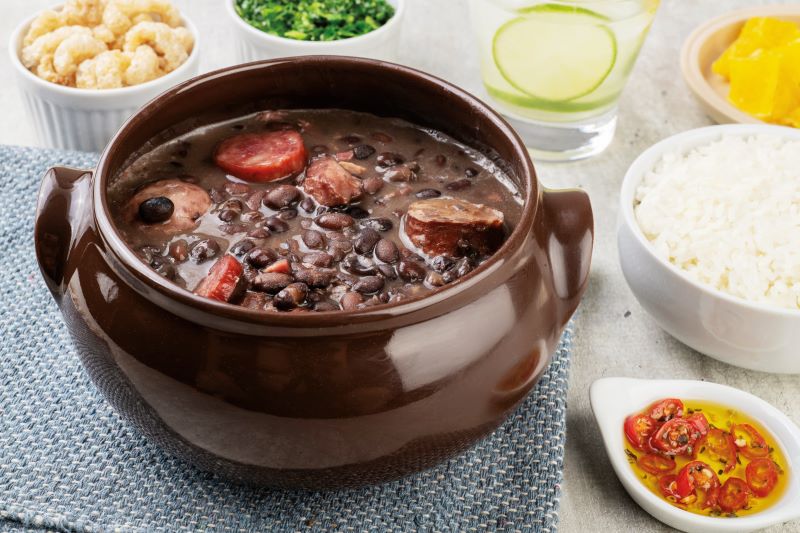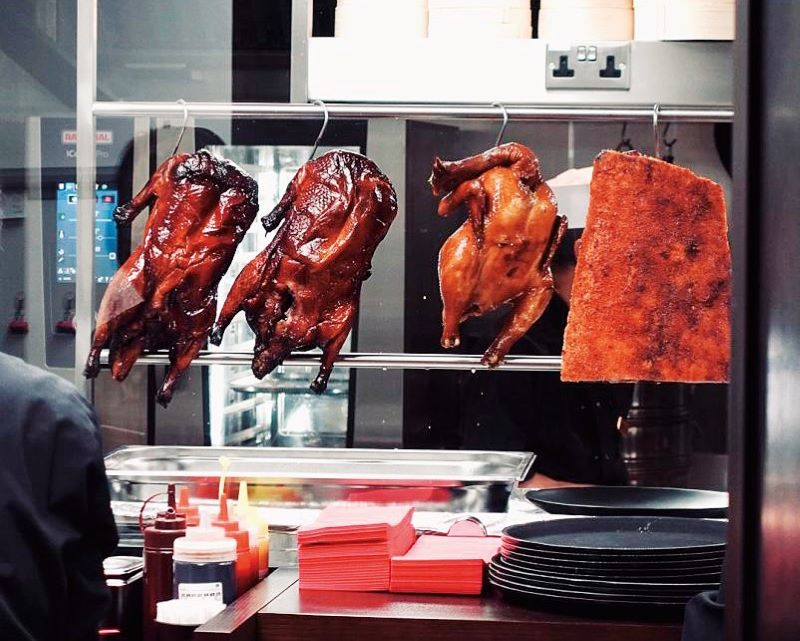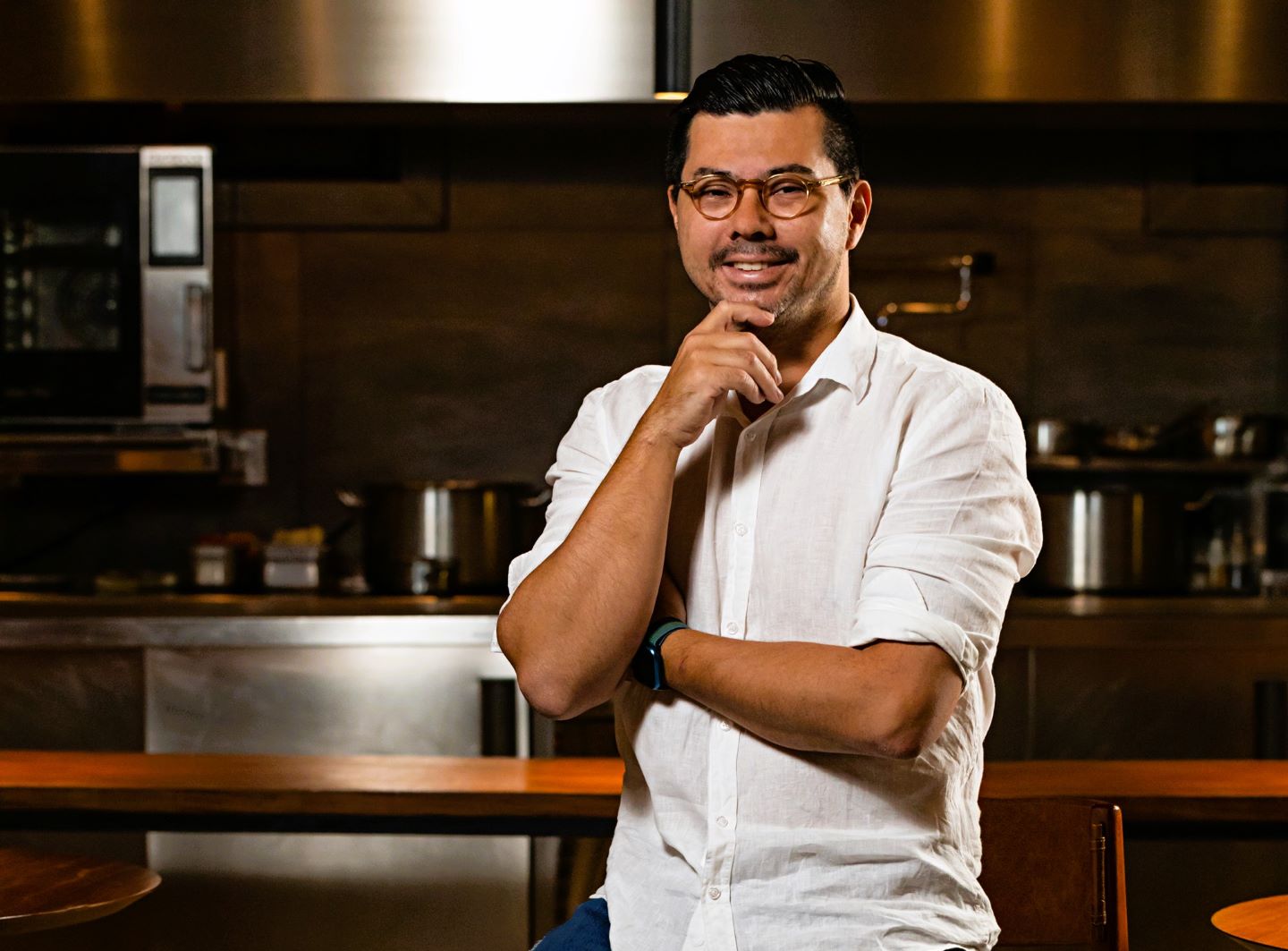
Landgraf is of German-Japanese origin (Photo: Oteque)
For travellers familiar with Rio de Janeiro’s inimitably cool vibe, it should come as no surprise that its hottest (and most decorated) restaurant hails from Botafogo. Sure, there are tonier districts like Copacabana, Leblon and Ipanema — the priciest due to their collective proximity to the most desired strip of Atlantic coastline in the country — but Botafogo captivates with a different kind of energy instead: edgy, alternative and experimental.
One person riding this creative wave and positively hanging ten is Alberto Landgraf. Of German-Japanese origin (quintessentially Brazilian considering these two groups make up the largest migratory populations in Brazil after the Portuguese, Italian and Spanish), Landgraf is the chef and talent behind Oteque.
MUSIC + MODERNISM
Oteque, the Rio de Janeiro dining room that turned the fine-dining world on its snooty head with its two Michelin starred rock ’n’ roll approach, is where Landgraf holds court. The restaurant’s name means “the place of” in Latin, but true to the chef-owner’s alternative music predilection, Oteque is also a tongue-in-cheek reference to Idioteque, a song from post-modern, angst-saturated Brit group Radiohead’s acclaimed Kid A album. “I liked the song a lot and wanted to have a name that comes from or is related to music, which is something present in my life always,” Landgraf says casually over a WhatsApp phone call as he waits to board yet another plane to yet another city. “My love for rock began when I was about 10 years old and watching MTV. I’ve liked it ever since.”
Located along fashionable Rua Conde de Irajá in an old house that dates back to the 1930s, Oteque remains one of the rare fine-dining rooms to blast Billy Idol and Lynyrd Skynyrd while its well-heeled guests gingerly pick on raw tuna with seaweed vinaigrette or slipper lobster ravioli. “Music has power on people and I wanted something more fun than, say, instrumental jazz,” says the chef. “But it’s not just grunge or rock, trust me.” And indeed, it isn’t. A quick scan of Oteque’s playlist, available on Spotify, reveals a range of eclectic hits like 1979 by The Smashing Pumpkins, Light My Fire by The Doors and Personal Jesus by Depeche Mode.
img-9339.jpg
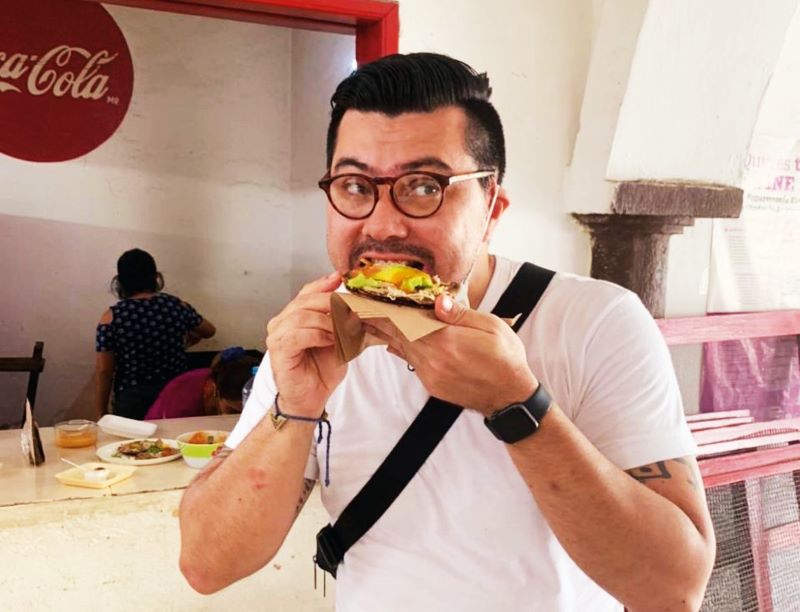
“On the day we opened Oteque, we didn’t have a playlist prepared yet so we just played the music I enjoy, the music I like to listen to in my personal life. My favourite bands of all time are Deep Purple, Pink Floyd, Nirvana and Judas Priest but I also play a lot of 1980s music like A-ha. I was a little worried as to how guests would take to the music initially but everyone so far — except for one or two complaints — enjoys it. People underestimate how much music influences the dining mood, but it is something I am very much aware of. I like that people have a joyful and memorable experience. Music evokes memories the same way food does.”
Oteque is described as a veritable culinary temple by its legion of fans, but you can forget about starched linen and poncy waiters there. In fact, you would be hard-pressed to find white tablecloths at all. “After the Scandinavian movement led by Noma, people began to pay more attention to the food as opposed to the décor,” Landgraf explains. “Western restaurant culture is also more influenced by Asia now. There is minimalism, which wasn’t there before. You go to a three-Michelin-star restaurant in Tokyo and there could be nothing in terms of décor but bareness … a piece of wood maybe. I am not alone in this. A lot of chefs have walked this path and experienced success.”
OF NAIVETY + SERENDIPITY
Born in Cornelio Precopio in the southern state of Paraná to Alberto, a farmer, and Helena, a teacher, Landgraf is initially hesitant to elaborate much about his family. “I am a bit reserved in speaking as both my parents have passed away. I have a brother, a biologist and environmental engineer, who works in projects to restore the Atlantic rainforest — not to be confused with the Amazon — around Rio and Sao Paulo. This forest in the southern coast of Brazil is the one that is really in danger!”
He cites his childhood as “idyllic”, lived out mainly on the farm until he was seven or eight years old. “It was then that my mother decided to move us to a bigger town in order for us to attend better schools and get a better education. She was a teacher, after all. You could say I had the best of both worlds — a happy childhood on a farm surrounded by nature and animals, picking my own fruit and vegetables, as well as a good education.” And although he credits his mother as being a great cook, Landgraf says he harboured no gastronomic aspirations at all while growing up. “One thing I will say — it wasn’t my mum who inspired me to become a chef. As a child, I just ate food to feed myself.”
img-9338.jpg
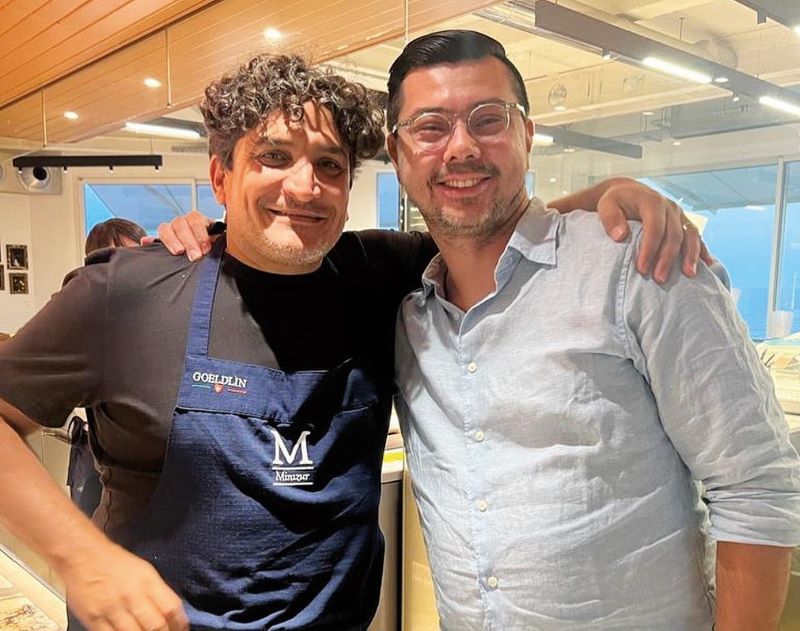
It was serendipity that led this highly cerebral chef (he has, after all, a degree in physics from his home-state university of Maringá) away from matter, motion and energy to the science of caramelisation, emulsification and the Maillard reaction instead. “I liked physics … but as a hobby,” he says matter-of-factly. “It was a subject I did well in school. But I did realise that, as a career choice, it was going to be very different and not very fulfilling either.” As a child, his ambitions were far more simplistic. “I wanted to be a farmer like my father,” he laughs. “But also an archaeologist, police officer and lawyer. Every day, I changed ideas and I can’t even remember all of them.”
It was while studying English in London and looking for a means to supplement his income that Landgraf worked a simple stint in a kitchen, sparking what would become an enduring, all-consuming culinary love affair. “I fell in love with the rhythm of the kitchen, with the flavours … it wasn’t boring. Every day was different.”
Upon returning to Brazil, he chose to put down culinary roots in Sao Paulo, opening Epice in 2008, winning a Michelin star soon after, but closing the restaurant in 2016. “I closed it as my mother passed away in 2015. It was a bad year for me, mentally-speaking. I really needed a break so I closed Epice in order to rest, recover and restructure my life,” he shares. It was in 2018 that Landgraf opened Oteque in Rio to critical acclaim while Bossa, his latest outpost in London and his first outside of Brazil, was unveiled just this summer.
KL CALLING
On his upcoming maiden visit to Malaysia as part of a culinary collaboration with EQ Hotel, an icon of Kuala Lumpur hospitality that celebrates its 50th anniversary this year, Landgraf is looking forward to the experience. “I have never visited Malaysia before. It will be my first time! I am very excited to see the place and get to know the people, the market, food, culture and art … all things I like and want to explore! I’ve heard only good things about Malaysian cuisine but I am also looking forward to introducing Brazilian food (done my way) and ingredients, which we are bringing in with the help of the Brazilian Embassy, like proper acai berries from the Amazon, tucupi [a yellow sauce derived from wild manioc roots] and good-quality raw Brazil nuts, to all of you. In fact, some of these ingredients are difficult to find even in Brazil!
alberto_landgraf_portfolio_6.jpg
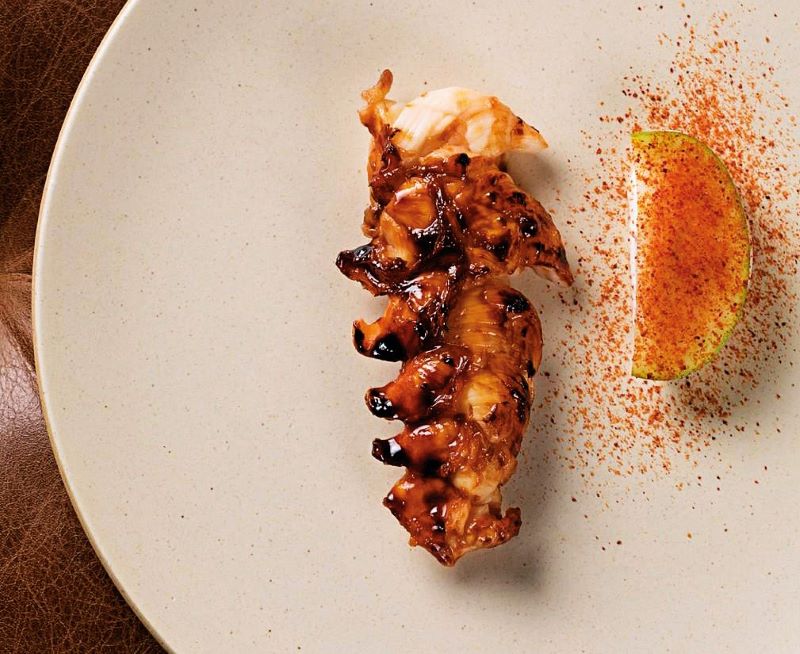
“I really want my work to speak for itself. Of course, in Kuala Lumpur, I might need to explain some ingredients as diners might not be familiar with them … also, there will be a lot of discoveries in store. But I would not elaborate a story that way. Ultimately, food needs to speak for itself. I think you can have a meal without people telling you a story about food,” he muses.
“However, I do have a rule that if I spent more time in the restaurant listening to waiters and sommeliers than eating the food and talking to my friends at the table, then there is clearly something wrong. What people can expect is that we will do our best. It will be our first time [in Malaysia]. We are sure we will find high-quality ingredients in the country and we will also bring some amazing ingredients from home. So, expect quality, new flavours and surprises … especially for those who have not yet been to Brazil!”
FUTURE-PROOFING
Already hailed as his country’s next culinary great after Alex Atala who first catapulted Brazil into global culinary consciousness via his Sao Paulo restaurant D.O.M., Landgraf acknowledges the pressure. “Which is not necessarily a bad thing,” he explains. “An athlete whom I admire a lot told me pressure is a privilege — and I agree. I am grateful for having reached this level with Oteque and that people consider us a possibility to be Brazil’s first restaurant with three Michelin stars. It is a privilege and it is this [drive] that brought me here and that will keep carrying me further down the road. But right now, I am not worried about surpassing myself or the expectations of others. To stay inspired, I make it a point to travel, eat in the restaurants of others, visit museums and keep meeting new people from different cultures, other fields of creativity and creative work. I just try to do my best every time.”
WHERE WOULD BRAZIL'S HOTTEST CHEF SEND YOU TO EAT?
Brazil
When you visit Brazil for the first time, for example, come with a long-enough schedule so you can visit not only cities like Rio and Sao Paulo, but also Minas Gerais, a countryside state with lots of local farms and great food. Be sure to also visit Bahia, which was the capital of Brazil for many years. Th ere is a lot of heritage left over from the days of the slave trade. It was from this dark period that two of Brazil’s most famous dishes originated: Feijoada, a black bean stew made with cheaper cuts of pork, and moqueca, a seafood stew with dende oil. Dende is the fruit of a palm that came on the boats with the Portuguese and grew well in Brazil. Its oil gives the moqueca its nice, bright orange colour.
THE UK
I have to say I learnt a lot from the English chefs. From my stints working with Tom Aikens, I learnt dedication. Tom is the most dedicated and talented chef I know. And from Gordon [Ramsay], I learnt planning and how to not just be a chef but also a businessman. I also learnt how to plan for the future [from him]. In London, my personal list includes Lyle’s along the Shoreditch High Street; Manteca, a nose-to-tail Italian place in Curtain Road; Chop Chop — a small place in Chinatown where I go for the crispy pork belly; Mountain — Tomos Parry’s new place in Soho; and The River Café, the Thames Wharf classic.
Japan
My perfect after-work supper is almost always Japanese-influenced. I’d get some leftover rice, stir fry it or mix it in with something, maybe braised beef or sea urchin, sliced truffles or whatever I have on hand or left over from dinner service. Th is is the best supper I can have ... any of these ingredients, mixed with very good cooked Japanese rice, ideally koshihikari. If you are in Tokyo, I would suggest you go eat at Den, which has two Michelin stars, Florilege in Shibuya, Katsuoboshi Okudo, the acclaimed Sushi Saito or, for traditional kaiseki, a place called Kanda.
The Sabayon x Alberto Landgraf promotion will be held from Aug 24 to Sept 7 at EQ Kuala Lumpur. Interested foodies may choose from the three-course lunch (from Thursdays to Saturdays only) or seven-course dinner menus (excluding Sundays), priced at RM328+ or RM788+ per person. (eqkualalumpur.equatorial.com)
This article first appeared on Aug 14, 2023 in The Edge Malaysia.

